Art Tools of Marc Holmes
Qn: Hi Marc, thanks for helping out with the interview. Do you mind giving our readers a brief introduction about who you are? I heard that you created art for video games, but I can't quite associate your drawing setup with video game art.
Good question! Let’s see….
I went to art school for design/illustration (Alberta College of Art and Design), and I do indeed work in video games. I was an art director for many years, most notably on RPG projects such as Neverwinter Nights and Lord of the Rings online. Eventually I got promoted to concept artist, (technically speaking a step back, but forward for my personal happiness!).
Most recently I’ve been working on the Dragon Age series for Bioware/EA. I also did a short stint as a concept artist in feature animation at Imagemovers/Disney. Now I freelance from my home in Montreal.
I have to admit a kind of artistic schizophrenia. All of the entertainment media art is digital. Usually drawn or painted in photoshop with a graphics tablet. Most of that work is meant to be very illustrative, using a lot of photographic reference and approaching “reality”, even when it’s fantastic subjects.
In my personal work I’m the complete opposite. I have a drawing based approach, very aggressive and gestural, very open to mistakes, weird line work, whatever happens in the moment. I prefer to draw from life, putting myself in front of interesting subjects. You can do your ‘best’ work in the studio, but I also like to experience the world first hand, even if the results are somewhat ‘sketchy’.
I’ve been blogging my ‘On Location’ work at citizensketcher.wordpress.com and a mixed array of digital work and figure drawing at tarosan.wordpress.com (Occasionally NSFW).
Qn: Can you give us a rundown of the brushes you use? Those look really well used. What's with taping for some of the brushes?
You’ll see a mix of nice sable brushes and the cheapest of synthetics in there. I often like a sharp, calligraphic kind of stroke, so I can draw shapes and have crisp edges. The cheap synthetics are actually best for that. But they suck for drybrush, or very expressive thick-to-thin line variation. So that’s why both.
The taping thing is
A: really old brushes with a cracked paint on the shaft can get wet and swell, loosening the ferrule. Newer brushes don’t seem to do this – they probably all have plastic shafts now.
B: I thicken the belly of the brush so they seat into the wire handles of bulldog clips (see shot below, brushes attached to the easel). Otherwise they just fall through.
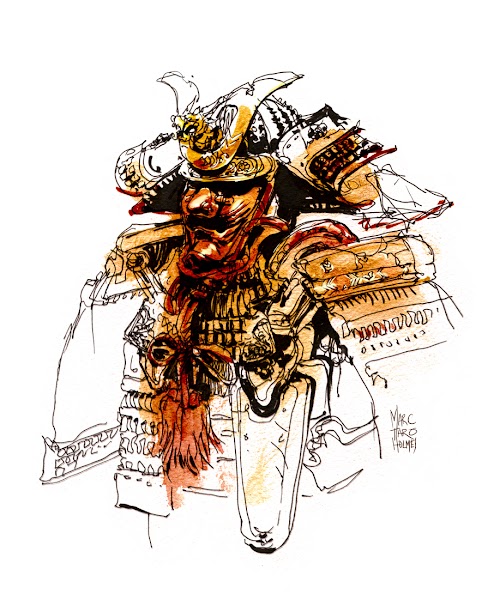
Qn: Which are your most frequently used brushes? Why do you like them?
There is a rust-red barreled one in there – (not the bright red one). It’s a #14 Escoda Reserva Kolinsky Sable made in Barcelona. It’s a moderately large brush if you’re working 9x12ish, but the perfect size to do the workhorse drawing at 12x16ish. It’s got a great point, but can be laid on the side for a fat stroke. So If I could have only one brush ever, that would be the one.
Every brush has a role though. That bright red one is a cheap ass thing that I like to use for grinding or stabbing the paper. Drybrushing foliage. There’s a long hair rigger second from the spine on the left – just for small tree branches, long hair on a model, things that need long slender strokes. I have an even longer haired one I should actually switch it out for. The big mop on the left is for skies and big areas of ground. Always use the biggest brush that fits in the shape you are doing.
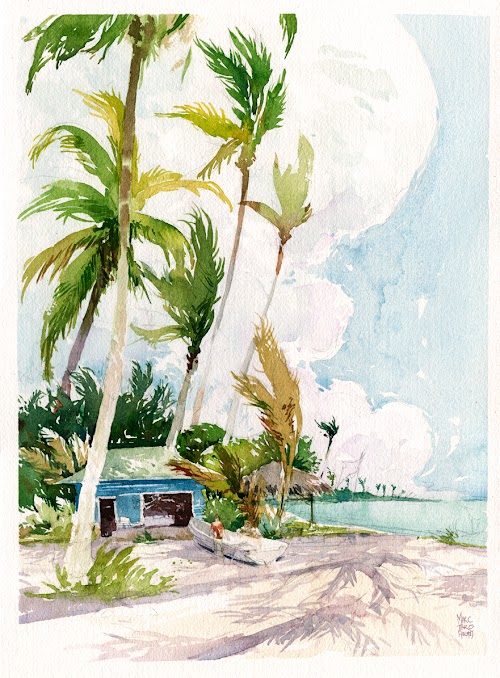
Qn: In one of your blog post, you mentioned that "Synthetic is fine. Natural sable is great." Why is that so?
I am on the cusp of ordering a whole new set of brushes. I might go all-sable soon. I just have to get over the mental block of spending $500 replacing all of them at once.
Sable has a few advantages. They hold more water, so the strokes are juicy and can go further. They can splay out and hold their shape, being better for drybrushing, and yet, (with a good one) they can have a very sharp point.
I have to admit, I have found sometimes the point is inconsistent in my old favorite Series 7 Windsor and Newton sables. This is one thing that sucks about the new reality of online shopping. You really should inspect every brush you buy. Most art stores will give you a cup of water to test the points. Not every brush of the same fiber comes out to the same final quality. It’s just the way of natural products.
On the other hand, you can do great work with synthetics, mostly you can’t tell the difference in the finished work. I would say synthetic will get you through your first 2000 paintings just fine.
Qn: Is that a dedicated pouch for storing brushes?
Yes, that’s a brush case – no idea the brand, they are quite discreet – no markings on them. But I’ve seen them at lots of art stores. This is really an important bit of kit. You have to treat the points of your brushes carefully. If you’re going to throw them into a shoulder bag it’s the only way. I have a bigger case for oil brushes with the longer handles.
Qn: What brands of watercolour are you using? Why do you have a preference over this particular brand? What do you think about their characteristics?
I choose them for the pigment, not so much the brand – so I have a mix of Winsor and Newton, Holbein right now. It’s just a matter of what color I need and what’s in stock.
I’m not savvy enough to say the difference in granularity or dispersion – I feel like I go for the color I need and adapt to the situation. The effect of humidity, temperature and paper is much more significant than any minor variation in manufactures paint quality anyway.
So I’d just say you get to know which brand is the shade of a color you like. One trick is, you can read the tiny numbers on the tube to see what it really is made of. W&N Cerulean Blue for instance is PB35. The ingredient names for pigments are standardized, so any brand with the same code is the same color. I bought a tube of Da Vinci Cerulean blue that is based on PB36, thinking it would be fine, and it’s actually a completely different color. Very acidic and greenish tinged. I hate it. It’s a big 2 ounce tube I’ll never use up. Unfortunately, it’s just a matter of experimenting and seeing what you like. I guess my advice is don’t buy the big tubes till you know you like a color.
Qn: How do you choose the colours? What are the must-have colours for you?
My basic colors are: Alizarin Crimson, Cadmium Red Light, Yellow Ocher, Cadmium Yellow Light Ultramarine Blue, Cerulean Blue. This is a very basic setup based on a warm and cool of each primary.
I have some ‘optional’ colors – I love Sap Green as a basis for foliage. One warm or cool it as required, almost never using it straight up.
I use Burnt Sienna and Prussian Blue as mixes to make darks. Combined with anything really, but often with the Alizarin Crimson.
I have this weird special effect colors Winsor Lilac (an opaque-ish light pink), that I use sometimes just for fun. It’s almost like white gouache and Alizarin Crimson. Something I can’t mix on the fly. I use it in skies for variety and flesh tones.
If I need some super dark darks I use Holbein Shadow Green (a powerful cool dark), Van Dyke Brown (a deep warm dark) and Lamp Black. I don’t use these much, but sometimes you need super dark darks.
It is very useful to have Opaque White Gouache and perhaps an Ivory Black Gouache. You can mix these with watercolor to make ‘body colors’ – opaque mixes that can be used bring back details on top. This is not traditional for watercolor, but can be useful at times.
Qn: Is there a particular way that you use to arrange the watercolours on your palette?
Basically, Primaries on the bottom, Earths and Darks on the side. You’ll see my two reds, two yellows, two blues along the bottom, with the special effect colors next to them. Lilac next to reds, Sap Green next to yellows. Prussian Blue next to the blues.
No particular reason, just habit so you can add new colors and know what’s in the wells. There is a blob of Cad Yellow Medium on there, taking up a slot. I haven’t used that blob in about a year, so I should take it out I guess.
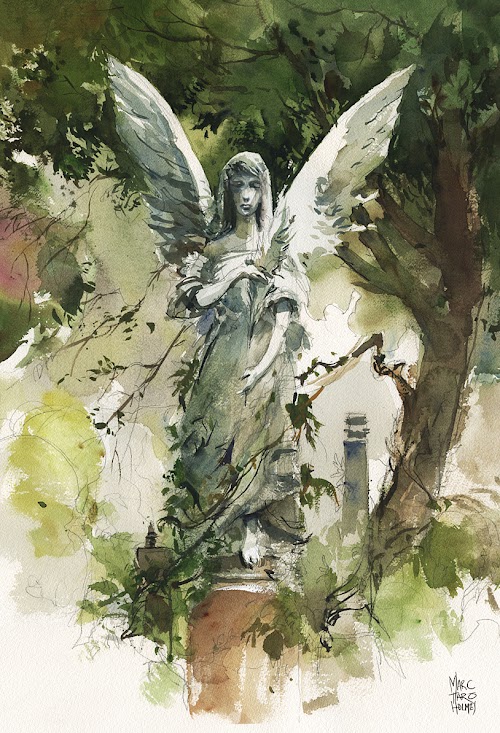
Qn: What's your advice for beginners looking to buy watercolours? What should they look out for?
I guess everyone knows don’t buy Student Grade paint. It’s basically all filler and not enough pigment, so your images will be weak and anaemic. Artist grade costs more, but it’s the only option really.
My other main peccadillo – I don’t much like pans. Not the dry ones for sure, they are the worst. You can’t get the right amount of pigment when you’re scrubbing them like a bar of soap. Its either too much, or nowhere near enough. To get a nice rich color, sometimes you want to pick up an almost pure dollop of pigment. The pans are just too miserly.
The semi-moist are not really much better. Bottom line: if you use pans, you won’t be able to mix complex colors. You’ll have a hard time making large washes, and/or getting enough pigment strength released from the pan. In general your paintings are likely to end up pale and cartoon-like. Pans are only useful for working in a small sketchbook by the side of the road in the south of France.
Sure, I have used them in the past – it’s how I got started (tinting over ink drawings), but these days I’d rather just draw in ink if I can’t have tube paint for space/portability reasons.
I know Charles Reid uses pans, but he’s super experienced. I think it’s the hard road going that way. So feel free to ignore me, but also add 5 years to your learning curve! Ha!
Qn What are those metal clips for?
Look down to shot of the fully set up easel – see how I use them to hold brushes? (as well as hold the taped paper-and-board on the tray). It makes a real difference – having all your tools at hand.

Watercolor is a very speedy medium. There are things you just have to do while a wash is wet. Once dried, the paint is inert. So anything that saves you groping for tools is important. You get a better piece if you can have the right brush instantly.
Qn: How about watercolour paper? What do you use?
The ‘correct’ answer is 300lb Arches Cold press. This is really the best paper. It’s got a great texture, great for drybrush effects. And in 300lb weight you don’t have to stretch paper (wont wrinkle).
BUT, I’ve been known to use a lot of cheaper machine made papers – Canson Montval pads and blocks are a standby for field sketching. I sometimes like a smooth, sized paper like the Montval. You can draw a nice sharp detailed image, and washes go on smoothly. So, I’ve done things on cheap paper I quite liked. But I know the Arches 300 is the best way to go, and now that I’m more confident with my drawing, that’s what I’m switching to as my mainstay.

Qn: And these two are?
Nalgene water bottle – totally leak proof, carry it around everywhere, never had a spill. Use one like it for oil painting solvent as well. 100% reliable. Plus a wide mouth you can swizzle your brushes in.
The ‘mist’ bottle (I think it’s an old hair spray container, must be 20 years old) – this is to ‘wake up’ your old paint in the palette. I mist them before starting, so the paint blobs get juicy and ready to spew color.
Qn: These look like your drawing tools. I can recognize the Lamy fountain pen. The bottom one's a pencil? Can you talk about them?
The top is a Lamy Safari fountain pen. That’s an EF (Extra fine), but I have Fine and a 0.9 calligraphy tip that’s a real bruiser. I use the Lamy house brand cartridges. Lots of people like the suction refill-gadgets to hand-fill with bottle ink, but honestly I can’t be bothered. If I want liquid ink, I’ll just use dip pens or a brush (see below for more on that).
The other reason I like the cartridges is they are NOT waterproof. (I’ll explain why I like that a bit further down.)
Below that is just a Staedtler mechanical pencil. I like a 0.7mm, as it’s a bit thicker line, useful if you’re drawing bigger. And the Kneaded rubber eraser – I think everyone knows these? These rubbery erasers are good for lifting graphite off the paper without damaging the surface. The white art erasers can be too rough on the paper tooth.
The deal with mechanical pencil - some people have been taught to use wooden pencils for ‘expressive line’ – but that’s really not the issue in a watercolor. You don’t want too much graphite under you paint. You can dirty the paper with too much drawing. I like a clean, spidery, drawing that shows through with nice sharp line work. Plus I hate sharpening on the go – either you make a huge mess with shavings, or you have a reservoir sharpener that gets full in 2 seconds and then opens in your bag making a huge disaster.
The brush pen in the shot is the old standby the Pentel Pocket Brush. Also known as the GFKP. Sometimes you have to search that name to find the refills online. It’s really a great brush pen, and I’ve used it for years. This is probably my fourth of these, eventually the cap breaks if you actually use the pocket clip. A very nice responsive tip, very fine lines but can also drybrush or lay down big blacks.
BUT – I will say I’ve switched to the Kuretake #13 brush pen. The tip is a little finer, a little more precise – and the ink cartridge is also NOT waterproof. The Pentel PB is fully water safe. So, again, I’m using the water-solubility as an effect these days.
Here’s a few ballpoint pen sketches with the Kuretake for accent.
Qn: Looks like dip pens and nibs you have above. What are they? How are they different compared to the Lamy fountain pen? I don't suppose you use these for outdoor urban sketching?
That is a Tachikawa nib holder and some Zebra Model G nibs, and a stray hunt crow quill I think. Both ordered from Jet Pens.
I do use them outdoors! – that’s why the tiny bottle of ink, and the even tiny-er bottle for carrying the nibs.
The dip pen is just so much better than any pen-pen. The line is much more expressive, much greater range of thick to thin. Plus you can change ink colors instantly. They are super easy to clean and you just toss them if they get worn out. Cheaper AND Better!
I’m using them for almost everything now. I can hold a sketchpad and the small bottle of ink in one hand, draw and dip with the other. Never had a spill in the three or four months I’ve been using them. Eventually I’ll pour ink in my lap or something, but hey. Live dangerously!
I have to admit – I have not shown any of the recent drawings done with the nib pen. A lot of them are for an un-announced book project. I’m going to have to do some just for the purpose of demonstrating the value of the nibs. It’ll be a year before I can talk about the book I’m hinting at.

Just a ballpoint. I do a lot of my speed gestures with ballpoint and brush marker. The 3 min or less drawings.
You’ll note all the little tin cases for erasers, cartridges and pens. These were from a Japanese stationary in San Francisco, and I wish I’d bought more sizes. They satisfy my deep-seated Asian need for containers to put inside containers.


Qn: When I first saw your easel in your blog post, I was impressed. That thing is like a piece of art by itself. Does not look anything like a traditional wooden easel. Where did you buy it? Or how did you make it? There's even a tray below. The setup looks amazing.
My wife is a photographer, so I could see from her gear that camera equipment is much better made than most artist oriented stuff. People love asking about these rigs, but it’s really nothing special. It’s all available at camera shops and online stores.
This was my first setup:
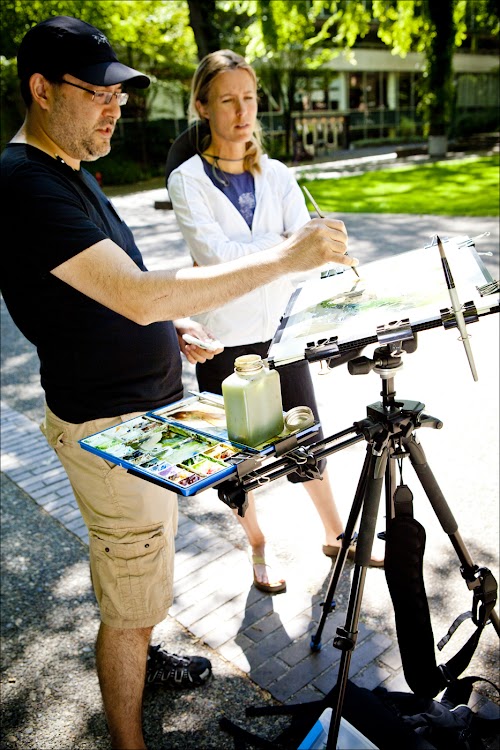
I don’t mind hauling around a tripod, but most people are not going to want to bother with this. It’s really overkill.

Ultimately I decided this tripod-and-arm combo was too heavy, too slow to set up. And the side arm (which is meant for an accessory microphone or a small camera) was too shaky.
So I upgraded to a new (more expensive) lighter weight setup:
This bigger black tripod (Manfrotto 055XPROB) is much more stable, goes taller, and has the “horizontal mode”. A really great system. But honestly I could not recommend to anyone they buy this setup, so I wasn’t going to mention it this time. It’s just too expensive, and frankly too big for most people to bother carrying around. But, if you are curious, all the parts are identified in that blog post you saw: People always ask about the easel.
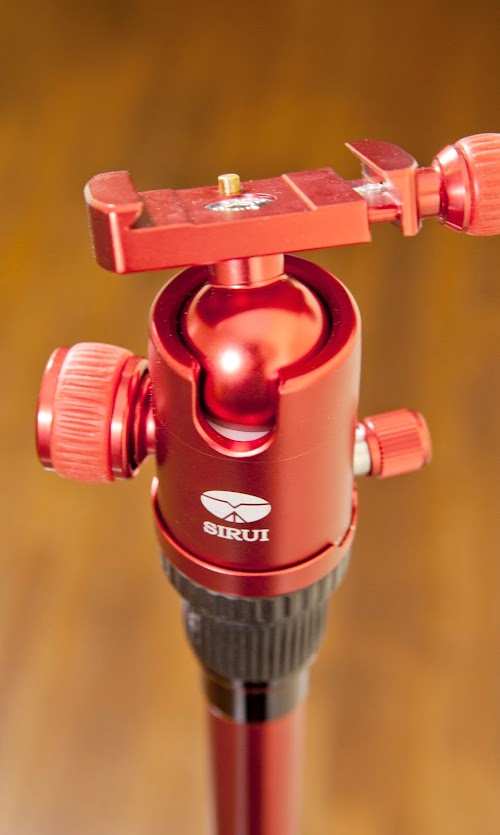

So this latest setup (the red one) is my compromise between portability and function. It’s a Sirui T-005. I once said I’d only have black camera gear, but apparently the world is moving on without me. Next thing you know we’ll have white phones.
The plastic trays are a product called the Eric Michaels En Plein Air Traveler. If you were a wood worker it would be simple to make your own trays. The connection you need between the tray and the tripod is called a T-Nut. I didn’t need to get crafty as I’ve had the E.M. Traveller for ages. I’d still be using the off-the-shelf Traveler, but I wore out the cheap tripod it ships with.
Qn: Is it heavy? The tripod looks big. Is it easy to setup?
The black Manfrotto 055XPROB is a bit heavy, 5.3lbs (~2.4kg) and 25” (63cm) folded (so carried over the shoulder).
The red Sirui is a slender 2.2lbs (~1kg) and folds down to 12” (30cm) and fits in a bag.
Both are fast to set up and take down and both can go plenty tall for standing to paint. I’m average height and I don’t use them at full extension. The Sirui has a hook under the centre column, from which you can hang your bag – giving it added weight if you need to counterbalance a big painting.
Qn: This is an interesting piece of work I saw on your blog. Seems like some watersoluble ink, but there are also some lines that didn't quite dissolve. What did you use?
This is that thing I was talking about! The water soluble inks. That’s the Lamy Safari and Kuretake #13 brush pen, both using their native cartridges.
You can simply wash it with clear water (being careful what you touch and what you don’t) and get instant grey values – or you can paint in with watercolor, and you colors get an automatic unifying, greying effect as the pen line melts into them. It’s great for an ‘unfinished’ look where the drawing shows through.
If your readers don’t mind some pin-up level near-nudity (Pasties Alert!) here’s some drawings from Dr. Sketchy’s with those pens and watercolor.
I first discovered this whole deal on sketching trip to Newfoundland in 2012. I was using the Lamy 0.9 calligraphy nib, and discovered how awesome it is to use water soluble ink line with watercolor. I have a video flip through (Inspired by parka blog!) of that sketchbook.
Qn: I saw you sketching on a sketchbook during the Urban Sketching Barcelona Symposium. What sketchbooks do you use?
That’s a Stillman and Birn Beta. Which is a damn nice watercolor book. 180lb/270gsm paper in a sketchbook! Got to be the nicest books for field work in watercolor.
For other things, I don’t mind the ubiquitous Moleskine, especially if I’m just drawing in pencil.
But I have to be honest, I am wanting to work larger these days, so I’m all about my 14x18” Coroplast backing boards and cut sheets. They are light enough I can carry a stack of 5 boards with paper on both sides, and that’s always been enough for a day on location.
Qn: Last question that's not related to your tools. I don't usually see video game or movie concept art being created in watercolour. It always puzzles me. Do you know why?
Two reasons. Well three.
1: Rapidity of revisions. In game/film design there is a lot of art direction and back and forth discussion. Working digitally allows you to make infinite changes to the work without ever having to re-do anything completely.
2: Perfection of vision, be it realism or a style or just hyper detail. Entertainment media is all about pushing graphics. Whatever the style we seem to want to constantly push for better graphics, bigger effects, more, more more. Traditional media can’t do this quickly (oil paints for instance are capable of anything, but it takes time). Watercolor is too idiosyncratic. It’s a media for ‘happy accidents’. Water flows into blooms and backwashes. I love the alchemy of water painting. Forcing it to be realistic is a shame. Whenever I see hyperrealist watercolors I just wonder ‘why bother’? It’s not natural to the expressive medium. If you want to obliterate the fluid dynamics and the brush strokes, to have a perfect photographic finish, just paint it digitally.
Third reason is just that it’s much easier to learn to paint digitally. The computer is a skill-magnification device. Like bringing a motorcycle to marathon. Digital art amps up your native ability.
But I’m not setting up for a traditional vs. digital fight. The best artists use whatever they want to get the effect, switching back and forth seamlessly. I’ve seen people paint, scan, do photoshop, print outputs and paint some more. I’ve done it myself in a way, making digital collages of sketches and printing a final drawing on Arches for a painting. You’d be surprised how much traditional art there is behind the scenes sometimes.
I love working both ways, and see some great possibilities for artists who embrace both sides!
Ok, thanks for having me! See you around the net!
~marc
Comments
If you have questions and comments for Marc, send them here: https://citizensketcher.wordpress.com/2013/12/07/up-on-parka-blog/

Check out other artist interviewees at https://www.parkablogs.com/tags/art-tools-and-gears

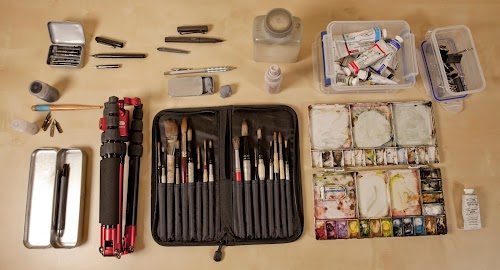
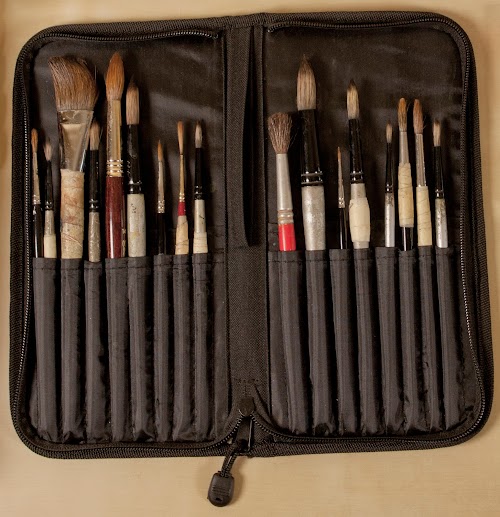
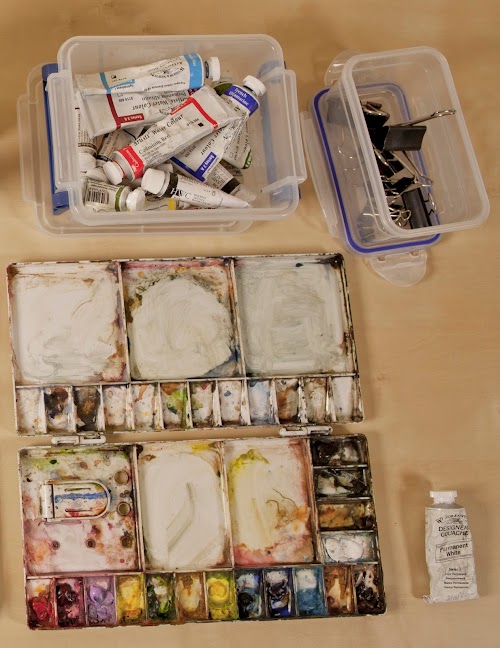
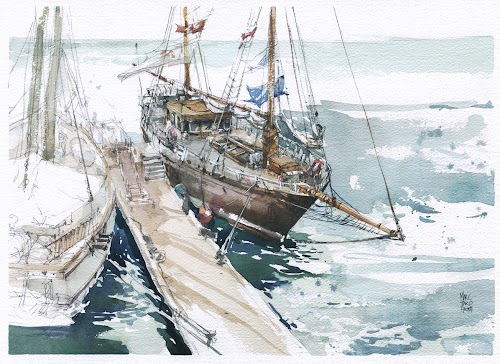



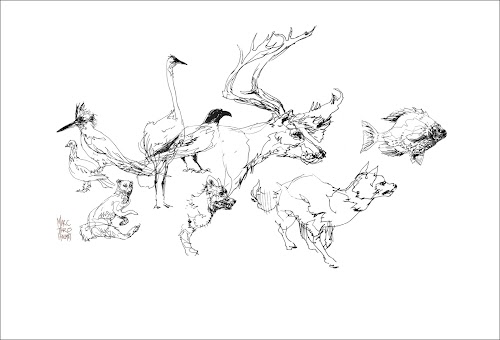








Comments
Cool to be up on the famous
Cool to be up on the famous ParkaBlogs - thanks! Chiming in here so I can track comments, fire away if anyone has further questions :) ~mth
Have you ever weighed your
Have you ever weighed your entire kit, paint, pens, clips, etc… what do you carry it all in. I really admire your work and have followed your blog for quite a while now… I'm glad you and Parka got together and did this equipment interview. Very informative.
I was curious what ink you
I was curious what ink you like to use with your dip pens?
No question, just one more
No question, just one more opportunity to express the admiration of this ex-montrealer!
Hey Elaine - yes, lets see -
In reply to Have you ever weighed your by Elaine Magliacane (not verified)
Hey Elaine - yes, lets see - everything I take normally, would be about 12 lbs (that's including a drink and powerbars) - plus a walkstool stool would be 14lb. (I usually stand, but on a day I know I'm doing longer paintings I'll carry a stool - most of the time I don't use it anyway!),
When I want permanent black,
In reply to I was curious what ink you by Stacy Egan (not verified)
When I want permanent black, I have a 16oz bottle of Higgins Waterproof I've been using for a while. I just squirt a bit into a .5oz bottle. I usually am not very selective about black ink - whatever they have in stock at the shop. (!) Lately I've been getting excited about water SOLUBLE ink - I've ran into a rep for Private Reserve fountain pen inks who provided me with a range of colors. I'm liking their Vampire Red for figure drawing. (If you don't mind some nekkid drawings, here's some examples: https://tarosan.wordpress.com/2013/11/12/water-soluble-sketching-with-p…). I expect any fountain pen ink labeled 'washable' would work to some extent. Theirs seems ideal for 'melting'.
Good questions, keep them
Good questions, keep them coming!
Where did you find that case
Where did you find that case for you brushes? Or where can I find something similar?
Thank you for the reply, Marc
In reply to When I want permanent black, by Marc Taro Holmes (not verified)
Thank you for the reply, Marc! I have a small bottle of Higgins Waterproof Black Magic but I haven't yet got the knack for using that ink with a dip pen compared to Higgins Eternal (which is unfortunately not waterproof). For water-soluble ink I like Private Reserve Velvet Black in a fountain pen. When released with water, there are some nice red tones; Pilot inks (like in Pilot Precision V5 & V7) are also nice, but release into more neutral grays from my experience.
Hey Caleb - I just picked it
In reply to Where did you find that case by Caleb (not verified)
Hey Caleb - I just picked it up at our local art store - but you can get them on Amazon: https://www.amazon.com/16-Piece-Artist-Brush-Set-Zippered/dp/B002E0IM04…
~m
Awesome you are into Private
In reply to Thank you for the reply, Marc by Stacy Egan (not verified)
Awesome you are into Private Reserve as well :) I think they aced the name of that line of ink. I feel cool every time I use them :) Now they just need to ship the bottles wrapped in oil cloth with a wax seal.
Beautiful and inspiring work!
Beautiful and inspiring work!
Something I don't often see addressed but given your bio, you might be able to help me out with - cold weather outdoor sketching. And I mean Edmonton cold. Other than the obvious wear the right cloths, have you braved the elements in the winter and if so, how does it affect the tools you use?
Again, absolutely stunning work!